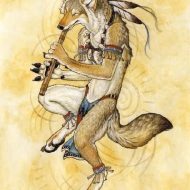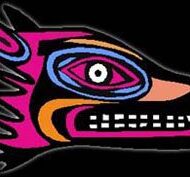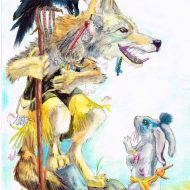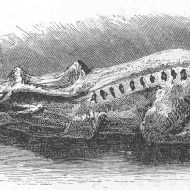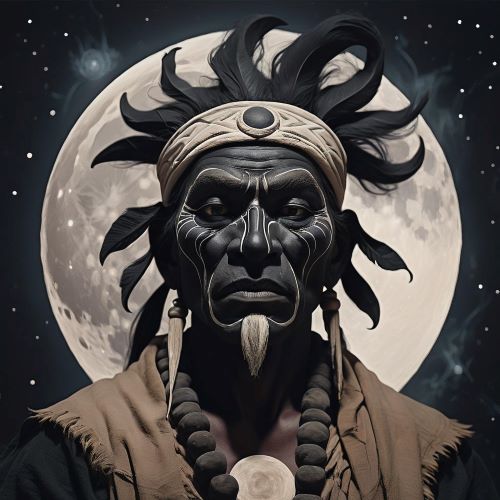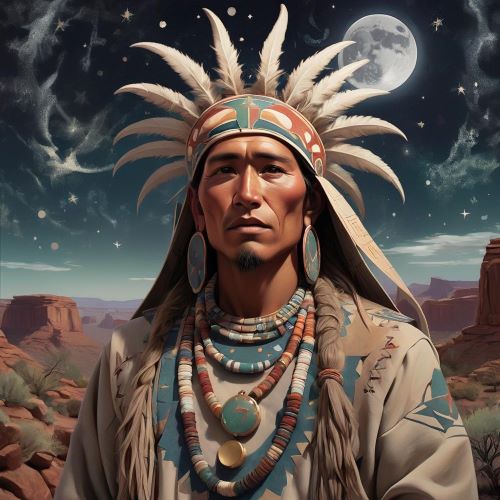M’ii : The Coyote Trickster of the Plains
Listen
At a glance
| Description | |
|---|---|
| Origin | Navajo Mythology |
| Classification | Gods |
| Family Members | N/A |
| Region | United States of America |
| Associated With | Trickery, Forgery, Water |
M’ii
Introduction
M’ii, often known simply as Coyote, is one of the most influential and paradoxical figures in Navajo mythology. Embodying both wisdom and mischief, she serves as a trickster, creator, and teacher whose stories reveal deep truths about the Navajo worldview. Although sometimes portrayed as foolish or reckless, M’ii is equally revered for her role in shaping the world and influencing the moral and natural order.
In Navajo cosmology, M’ii plays a key role in creation myths and sacred narratives such as the Blessingway, a central ceremonial tradition that celebrates balance and harmony. Despite her chaotic tendencies, she is considered part of the divine order, illustrating how disorder and unpredictability coexist with creation. M’ii’s tales form the moral foundation of Navajo storytelling, blending humor with lessons about respect, responsibility, and the delicate balance between human behavior and the forces of nature.
Physical Traits
M’ii is most commonly represented in her animal form—a coyote with keen, intelligent eyes and an ever-watchful expression. She may also appear in human form, often as a wise and shrewd woman capable of blending into human society. These two forms reflect her duality: one part divine trickster tied to nature, another part moral observer within the human world. Her shifting identity underscores her ability to move between realms, both guiding and testing humankind through her transformations.
Family
M’ii’s family connections in Navajo mythology are deeply symbolic rather than strictly genealogical. She is often described as the companion and counterpart of Changing Woman (Asdzą́ą́ Nádleehi), one of the central deities of the Navajo pantheon. Through her association with Changing Woman, M’ii participates in the cosmic balance between creation and disruption—her mischief offsetting the goddess’s nurturing and order.
She is also tied to To Neinilii, the rain god, with whom she shares power over water and storms. In some stories, their interactions reflect a rivalry, as both wield the forces that sustain and challenge life. Other myths link M’ii to the Holy People (Diyin Dine’é), suggesting that she was once one of them before her reckless actions caused her to fall from grace. Despite this, M’ii remains connected to divine powers, acting as an intermediary between the spirit world and humanity.
Other Names
M’ii is known by several names across different Native American traditions, reflecting her widespread influence and the shared archetype of the Coyote Trickster. In Navajo, Mąʼii (pronounced “M’ii”) literally means “coyote,” but it carries far more spiritual weight than the English translation implies. Among other Southwestern tribes, she is known as Ma’ii Dzíłchi’, “Coyote Woman,” or Mąʼii tsoh, “Great Coyote.”
Outside Navajo culture, similar trickster figures appear in neighboring mythologies. The Hopi refer to her as Isotka or Sotuknang’s Coyote, while in Zuni and Apache traditions, the coyote takes on comparable roles as both fool and teacher. These cross-cultural versions highlight M’ii’s universality as a force of transformation, creativity, and moral instruction across Indigenous North America.
Powers and Abilities
M’ii is a figure of contradiction—both creative and destructive, benevolent and deceptive. Her powers include shapeshifting, illusion, and control over natural forces, particularly water and rain, which she shares with the rain god To Neinilii. She is often credited with establishing the stars in the sky, creating constellations by whimsically flinging them into the heavens, and shaping the geography of the world through her misadventures.
M’ii also plays a crucial role in Navajo cosmology’s cyclical worlds. She is responsible for bringing humans into the Fourth World—the Earth we now inhabit—after the great flood destroyed the previous realm. Through these actions, M’ii’s stories serve as both warnings and teachings, reminding people of the consequences of pride, greed, and carelessness, while celebrating cleverness and adaptability as essential virtues for survival.
Modern Day Influence
In modern Navajo culture, stories of M’ii continue to serve as moral and educational tools. Parents and elders share her tales to teach children the importance of respect, humility, and awareness of one’s actions. Beyond the reservation, M’ii has become a cultural symbol of indigenous wisdom and resilience, appearing in literature, art, and educational curricula that preserve and celebrate Native American identity.
In popular media, the image of the coyote as a cunning, witty survivor owes much to figures like M’ii. Though her behavior often leads to trouble, it also reflects the enduring spirit of adaptability and creativity that defines the Navajo worldview. M’ii’s laughter, wisdom, and mischief ensure that her presence continues to weave through both myth and modern life.
Related Images
Source
Franz, R. Trickster Tales: Coyote and Native American Mythology.” Journal of American Folklore, vol. 120, no. 477, 2007.
Kramer, Jeffrey. Myths of the Navajo. New York: Harper & Row, 1968.
McPherson, Robert. “The Trickster in Native American Literature.” The Journal of Native American Literature, vol. 15, no. 1, 2020.
Bierhorst, J. (1984). The Mythology of North America. William Morrow and Company.
Matthews, W. (1897). Navaho Legends. American Folk-Lore Society. Retrieved from https://www.sacred-texts.com/nam/nav/leg/index.htm
Native Languages of the Americas. (n.d.). Coyote the Trickster. Retrieved November 13, 2025, from https://www.native-languages.org/legends-coyote.htm
Erdoes, R., & Ortiz, A. (1984). American Indian Myths and Legends. Pantheon Books.
Leeming, D. A. (2009). The Oxford Companion to World Mythology. Oxford University Press. Retrieved from https://www.oxfordreference.com/display/10.1093/acref/9780195156690.001.0001/acref-9780195156690
University of Arizona Press. (2011). Coyote Tales: Reconstructing Native American Trickster Traditions. Retrieved from https://uapress.arizona.edu/book/coyote-tales
Frequently Asked Questions
What is Ma II in Navajo?
Ma’ii is a very important figure in Navajo mythology and storytelling. He’s known as a trickster, often mischievous and cunning. However, he also plays a crucial role in bringing fire to humanity, teaching valuable lessons, and representing the transformative power of change.
What does Maii mean in Navajo?
Unfortunately, “Maii” without the apostrophe or macron doesn’t have a direct meaning in Navajo.The word for coyote in Navajo is ma’ii with the glottal stop, which differentiates it from other words.
What gods are associated with coyotes?
The coyote as a symbol and figure is prevalent in many cultures across the Americas, and it often holds religious significance due to its unique characteristics and adaptability. Ma’ii (Navajo is a prominent trickster deity, responsible for creating fire, teaching humans vital lessons, and embodying change.
What animal is a trickster god?
The coyote is the most famous trickster god animal, appearing in many North American indigenous cultures. He’s known for his mischievousness, cunning, and ability to teach valuable lessons through his antics.


